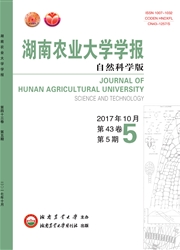

 中文摘要:
中文摘要:
以川西名山县处于同一地形序列上的漂洗水稻土、黄壤和酸性紫色土3种主要茶园土壤0~20 cm土层为研究对象,于春、夏、秋3个季节采样,对土壤pH、交换性酸含量、水解性酸含量、酸碱缓冲能力及石灰需要量等进行分析。结果表明:1 3种茶园土壤pH均低于4.5,不适于无公害茶叶生产。交换性酸均以交换性铝为主,交换性铝含量和交换性酸含量均以漂洗水稻土的最低。水解性总酸度表现为酸性紫色土显著高于漂洗水稻土,酸性紫色土和漂洗水稻土的水解性总酸度与黄壤的差异均无统计学意义。漂洗水稻土以非交换性酸为主,黄壤和酸性紫色土以交换性酸为主。2 3种茶园土壤交换性氢含量、交换性铝含量、交换性酸含量和水解性总酸度等指标由于地形条件、气候特征、茶树生物学特性和人类活动等影响而总体上呈夏季低于春(秋)季的趋势变化。3 3种茶园土壤的酸碱缓冲曲线均呈“S”型,但土壤缓冲容量有差异,表现为酸性紫色土、黄壤、漂洗水稻土的缓冲能力依次减小。4 3种茶园土壤必须进行改良,但用不同方法计算出的石灰需要量有较大差异,建议将氯化钙交换–氢氧化钙滴定法得出的石灰需要量结合田间试验进行校正;若调节至同一pH,漂洗水稻土的石灰需要量相对较少。
 英文摘要:
英文摘要:
Soil acidity is an important environmental element for non–polluted tea production. Soil samples, within 20 cm of surfaces in bleached paddy soil, yellow earth and acid purple soil at the same toposequence in Mingshan county of west Sichuan, were collected in spring, summer and autumn, and soil pH, exchangeable acidity, hydrolytic acidity, pH buffer capacity and lime requirement were further measured. The results showed that: 1pH values of 3 types of tea garden soils were lower than 4.5. Among of them, that of yellow earth was the lowest with the mean value 3.79, and the maximum value 4.19. Hence, the soils were not conducive to non–polluted tea production, and must be improved. Among of 3 types of tea garden soils, exchangeable H+ content was the highest in yellow earth, exchangeable Al3+content and exchangeable acidity(include H+ and Al3+) was the lowest in bleached paddy soil. However, the exchangeable acidity was mainly composed of exchangeable Al3+ for every soil. For hydrolytic acidity, acid purple soil was significantly higher than that of bleached paddy soil, but there was no significant difference in hydrolytic acidity between yellow earth and acid purple soil or bleached paddy soil. The hydrolytic acidity in bleached paddy soil was mainly composed of non–exchangeable acidity, but that of yellow earth and acid purple soil were mainly composed of exchangeable acidity. 2 the exchangeable H+ and Al3+, exchangeable acidity and hydrolytic acidity were lower in summer than that in spring or autumn respectively, which were driven by climate and biology factors. 3 the soil pH buffer curves of 3 types of tea garden soils were all presented in "S" shape, but there were differences in soil buffer capacity among the 3 types of tea garden soils. The soil buffer capacity of acid purple soil, yellow earth and bleached paddy soil decreased successively. 4 the lime requirement in acid soil must be determined using calcium chloride exchange– calcium hydroxide titration firstly, and then adj
 同期刊论文项目
同期刊论文项目
 同项目期刊论文
同项目期刊论文
 期刊信息
期刊信息
